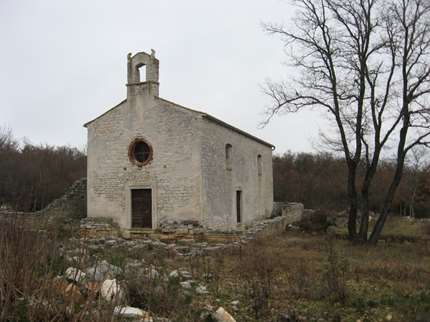Return
The Church and the Monastery of St. Mary the Great
The original church of St. Mary the Great, not far from Bale, was a large three-nave basilica. The church changed in the course of time. The smaller Baroque church was built in the 17th c.
The Baroque Church of St. Mary the Great near Bale from 1789 was abandoned following the collapse of its roof in the mid 20th c. The explorations of the church and its surrounding, which have lasted since 1995, pointed to the existence of an earlier structure, an Old Christian church and a monastery. The original church was a large three-nave basilica, which naves were partitioned by six pairs of columns with different capitals, basket and Corinthian ones. Clearly representing the transformation of the Late Antiquity heritage, and although somewhat cumbersome, they are an exceptionally expressive work of the capital master from Bale. The capitals made it possible to date the church to the late 8th or the early 9th cc. as the Caroline structure. The basilica layout with the three emphasized apses, semi-circular from the inside and polygonal from the outside, reflect its Byzantine heritage underlined by the gables with crosses of expanded tip ends and a mushroom door opening on the church northern nave. In the course of time, the church underwent some changes. In the 11th c., it was shortened by a colonnade. The newly established antechamber was used for burials and the belfry construction. The church was then added a new choric partition as well as the single-nave memorial chapel. During the following historic period, the monastery and the church were slowly dilapidating, only to re-gain their economic purpose in the 17th c. A small Baroque church was built during the same time, on the site of the basilica's earlier central nave. Apart from the church, bigger parts of the monastery were also explored, primarily those south from the church with the tiled gallery, which was most probably a part of the central cloister. The southern part has an arched portico, which expands into a central area, while the east wing of the monastery holds a number od rooms. The monastery and the Church of St. Mary the Great is one of the earliest monasteries in Croatia designed and executed under set rules.





